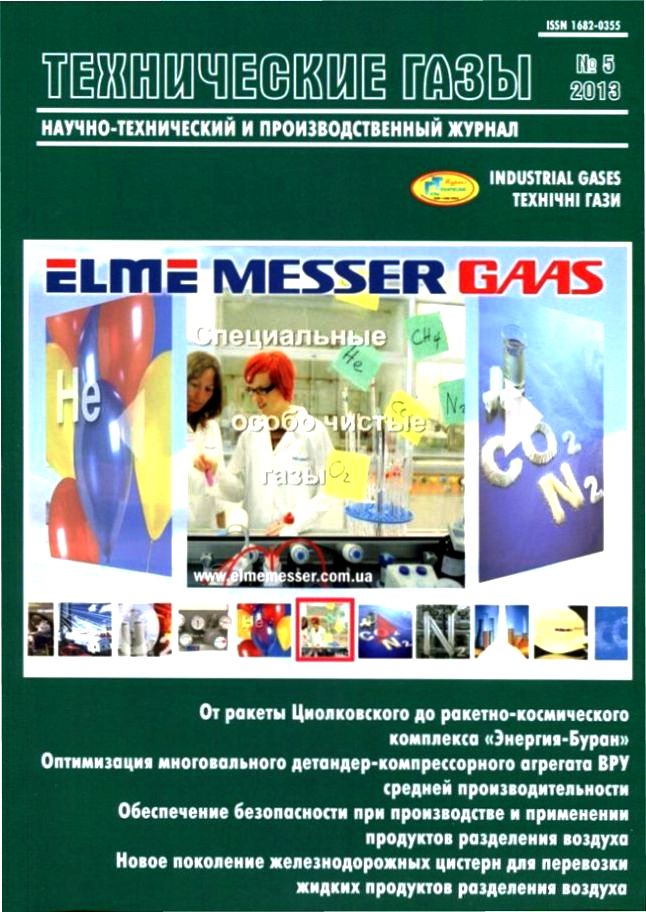ОПИСАНИЕ РАВНОВЕСИЯ ЖИДКОСТЬ–ПАР В БИНАРНЫХ СМЕСЯХ АЗОТА, АРГОНА И КИСЛОРОДА
DOI:
https://doi.org/10.18198/j.ind.gases.2013.0698Ключевые слова:
Азот, Аргон, Кислород, Бинарные смеси, Равновесие жидкость-пар, Уравнения фазового равновесияАннотация
Усовершенствована форма уравнения для расчёта данных о фазовом равновесии жидкость-пар в бинарных смесях. Уравнение отображает давление смеси как сумму линейной комбинации значений давления насыщения компонентов и нелинейной функции от состава и температуры. Форма уравнения автоматически удовлетворяет условию о плавном переходе давления смеси в давление компонента при соответствующем увеличении его концентрации. Усовершенствование формы уравнения по сравнению с рассмотренными ранее [7, 8] заключается в увеличении гибкости выражения для нелинейной функции. Это позволило существенно уменьшить количество коэффициентов в указанной функции при сохранении приемлемой точности описания опытных данных. Эффективность модифицированной формы уравнения проверена на примере описания надёжных экспериментальных данных о фазовом равновесии в смесях азот-кислород при температурах 65…120 К, азот-аргон при 77…120 К и кислород-аргон при 80…120 К. Составленные уравнения позволяют рассчитывать любой из трёх параметров фазового равновесия (р, Т, х либо у) при двух заданных. Форма уравнения может быть рекомендована для описания данных о фазовом равновесии жидкость-пар в бинарных смесях при докритических температурах обоих компонентов.
Библиографические ссылки
Narinskiy G.B. (1967). Liquid-vapor equilibrium in systems oxygen-nitrogen, oxygen-argon and argon-nitrogen// Trudy VNIIKIMASH [Papers of VNIIKIMASH] — Moscow: Mashinostroenie. — No. 11. — P. 3-45. (Rus.).
Narinskiy G.B. (1967). Rectification of air. — Moscow: Mashinostroenie. — 248 p. (Rus.).
Fastovskiy V.G., Rovinskiy A.E., Petrovskiy Yu.V. (1972). Inert gases. — Moscow: Atomic publishing house. — 360 p. (Rus.).
Golovko G.A. (1983). Cryogenic production of inert gases. — Leningrad: Machine building. — 416 p. (Rus.).
Malkov M.P., Danilov I.B., Zel’dovich A.G. et al., edited by M.P. Malkov. (1985). Handbook of physical and technical fundamentals of cryogenics. — Moscow: Energetics and atomic publishing house. — 432 p. (Rus.).
Bondarenko V.L., Simonenko Yu.M. (2013). Cryogenic technology of extracting rare gases. — Odessa: «Astroprint» — 332 p. (Rus.).
Vasserman A.A., Slyn’ko A.G. (2012). Description of phase equilibrium in binary mixtures containing rare gases, nitrogen or oxygen// Tekhnicheskie Gazy. [Industrial Gases]. — No. 2. — P. 56-61. (Rus.).
Vasserman A.A., Slyn’ko A.G., Galkin V.N. (2012) Equations for calculation of equilibrium liquid-vapor in binary mixtures of air components// Tekhnicheskie Gazy [Industrial Gases]. — № 6. — P. 59-63. (Rus.).
Skripka V.G., Lobanova N.N. (1978). Experimental research of the solubility of helium and neon in liquid oxygen, nitrogen and argon // Trudy VNIIKRIOGENMASH [Papers of VNIIKRIOGENMASH] — Moscow: Mashinostroenie. — No. 13. — P. 90-103. (Rus.).
Vasserman A.A., Kazavchinskiy Ya.Z., Rabinovich V.A. (1966). Thermophysical properties of air and its components. — Moscow: Science. — 348 p. (Rus.).
Rabinovich V.A., Vasserman A.A., Nedostup V.I. et al., edited by V.A. Rabinovich. (1976). Thermophysical properties of neon, argon, krypton, and xenon. — Moscow: Standarts publishing house. — 560 p. (Rus.).
Mulero A., Larrey D., Cuadros F. (2006). A new correlation for VLE data: Application to binary mixtures containing nitrogen// Korean J. Chem. Eng. — V. 23. — No. 4. —P. 650-657.
Dodge B.F., Dunbar A.K. (1927). An investigation of the coexisting liquid and vapor phases of solutions of oxygen and nitrogen// J. Amer. Chem. Soc. — V. 49. — P. 591-609.
Forsyth J., Malcolm M., Mouler K. (1980). Computer methods of mathematical computations. — Moscow: World — 280 p. (Rus.).
Загрузки
Выпуск
Раздел
Лицензия
ЛИЦЕНЗИОННЫЙ ДОГОВОР
После приёма статьи к публикации редакция согласно требованиям наукометрических баз каждому из авторов направляет лицензионный договор об уступке и передаче в управление авторских прав. Подписи автора (авторов) желательно скрепить печатью отдела кадров учреждения, в котором работает автор (авторы), или печатью факультета.
Редакция отсылает авторам одну верстку для корректуры. Допустимы лишь те исправления, которые приводят верстку в соответствие с исходным текстом статьи. Внесение существенных изменений не допускается. Верстку следует выслать в редакцию в течение суток с момента получения.

